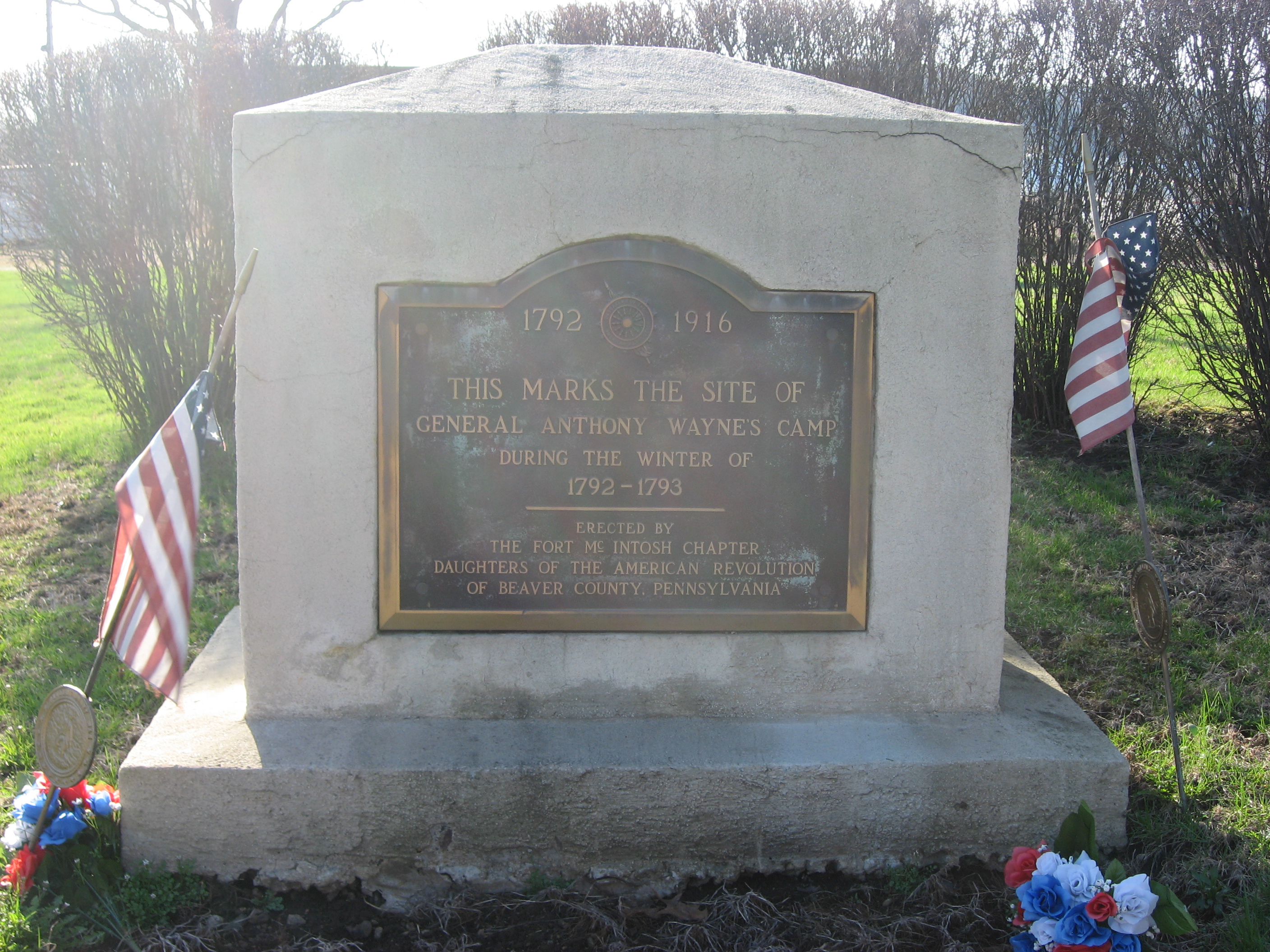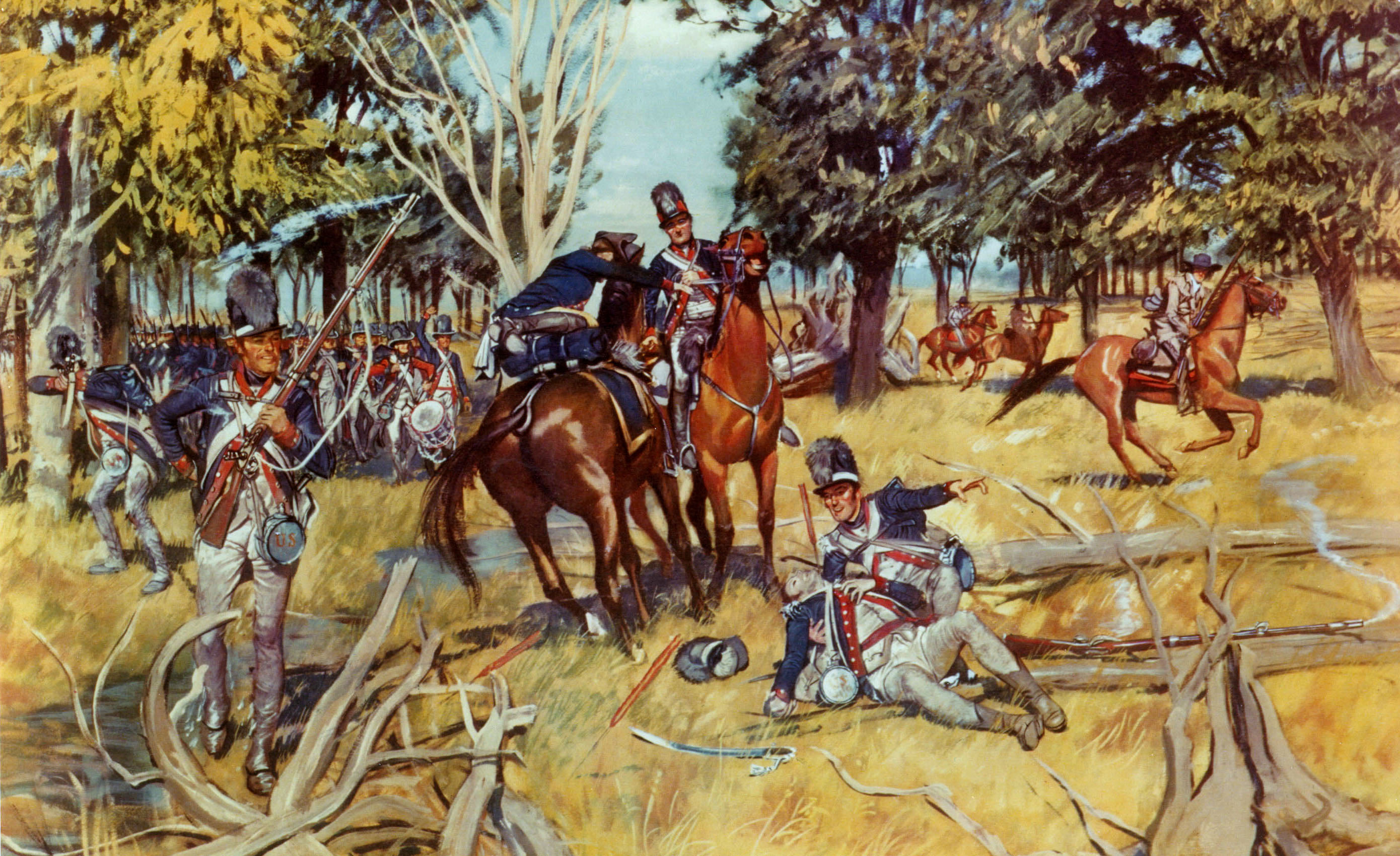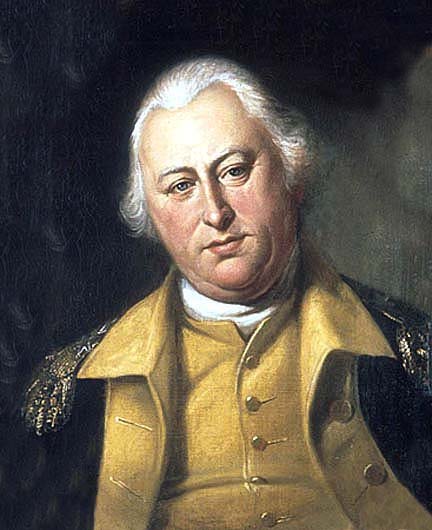|
Legionville
Legionville (or Legion Ville) was the first formal basic training facility for the military of the United States. The camp, which was established in winter 1792 under the command of Major General Anthony Wayne, was near present-day Baden, Pennsylvania, a suburb of Pittsburgh. It was used to train the soldiers which would become the Legion of the United States. Throughout the winter of 1792-93, existing troops along with new recruits were drilled in military skills, tactics and discipline. The following spring the newly named Legion of the United States left Legionville for the Northwest Indian War, a struggle between American Indian tribes affiliated with the Western Confederacy in the area north of the Ohio River. The overwhelmingly successful campaign was concluded with the decisive victory at the Battle of Fallen Timbers on August 20, 1794. The training the troops received at Legionville was seen as instrumental to this victory. Background The United States military real ... [...More Info...] [...Related Items...] OR: [Wikipedia] [Google] [Baidu] |
Legion Of The United States
The Legion of the United States was a reorganization and extension of the United States Army from 1792 to 1796 under the command of Major General Anthony Wayne. It represented a political shift in the new United States, which had recently adopted the United States Constitution. The new Congressional and Executive branches authorized a standing army composed of professional soldiers rather than relying on state militias. The Legion was primarily formed in reaction to multiple defeats in the Ohio country in 1790 and 1791 and to assert U.S. sovereignty over U.S. borders in the western territories and Great Lakes regions. The Legion comprised four sub-legions, each with infantry, cavalry, riflemen, and artillery. The Legion is best known for its victory at the Battle of Fallen Timbers in August 1794. Following the 1795 Treaty of Greenville with the Western Confederacy of Native American nations and the Jay Treaty with Great Britain, the Legion was reduced in size and rechristen ... [...More Info...] [...Related Items...] OR: [Wikipedia] [Google] [Baidu] |
Anthony Wayne
Anthony Wayne (January 1, 1745 – December 15, 1796) was an American soldier, officer, statesman, and a Founding Father of the United States. He adopted a military career at the outset of the American Revolutionary War, where his military exploits and fiery personality quickly earned him a promotion to brigadier general and the nickname "Mad Anthony". He later served as the Senior Officer of the Army on the Ohio Country frontier and led the Legion of the United States. Wayne was born in Chester County, Pennsylvania, and worked as a tanner and surveyor after attending the College of Philadelphia. He was elected to the Pennsylvania General Assembly and helped raise a Pennsylvania militia unit in 1775. During the Revolutionary War, he served in the Invasion of Quebec, the Philadelphia campaign, and the Yorktown campaign. Although his reputation suffered after his defeat in the Battle of Paoli, he won wide praise for his leadership in the 1779 Battle of Stony Point and was ... [...More Info...] [...Related Items...] OR: [Wikipedia] [Google] [Baidu] |
Harmony Township, Beaver County, Pennsylvania
Harmony Township is a township and census-designated place in Beaver County, Pennsylvania, United States. The population was 3,195 at the 2020 census. It is part of the Pittsburgh metropolitan area. Geography Harmony Township is located in southeastern Beaver County at (40.607217, -80.220321). According to the United States Census Bureau, Harmony Township has a total area of , of which is land and , or 5.21%, is water. Surrounding and adjacent neighborhoods Harmony Township has four land borders, including Baden to the north, Economy to the east, Ambridge to the southwest, and the Allegheny County neighborhood of Leet Township to the south. Across the Ohio River to the west, Harmony Township runs adjacent with Aliquippa. Demographics As of the census of 2000, there were 3,373 people, 1,439 households, and 991 families residing in the township. The population density was . There were 1,509 housing units at an average density of . The racial makeup of the township w ... [...More Info...] [...Related Items...] OR: [Wikipedia] [Google] [Baidu] |
Northwest Indian War
The Northwest Indian War (1785–1795), also known by other names, was an armed conflict for control of the Northwest Territory fought between the United States and a united group of Native Americans in the United States, Native American nations known today as the Northwestern Confederacy. The United States Army considers it the first of the American Indian Wars. Following centuries of conflict for control of this region, the land comprising the Northwest Territory was granted in 1783 to the new United States by the Kingdom of Great Britain in article 2 of the Treaty of Paris (1783), Treaty of Paris, thereby officially ending the American Revolutionary War. The treaty used the Great Lakes as a border between British territory (later a part of Canada) and the United States. This granted significant territory to the United States, initially known as the Ohio Country and the Illinois Country, which had Royal Proclamation of 1763, previously been prohibited to new settlements. H ... [...More Info...] [...Related Items...] OR: [Wikipedia] [Google] [Baidu] |
Baden, Pennsylvania
Baden is a borough in southeastern Beaver County, Pennsylvania, along the Ohio River. The population was 3,904 at the 2020 census. It is part of the Pittsburgh metropolitan area. Baden is the former site of Logstown, a significant Native American settlement. History The site of Baden was the location of Logstown, a Native American village. The Treaty of Logstown was signed by representatives of the Iroquois Confederation, Lenape and Shawnee leaders there; George Washington visited the area to speak with the Natives himself under Queen Alliquippa. The oldest recorded house in Baden was built in the early 1800s, and it became a stopping place for farmers on their way to Pittsburgh to sell their livestock. Baden was founded as a village in 1838 and was named after the German resort town of Baden-Baden at the border of the Black Forest. Early on, Baden was home to boat building yards, quarries, a lath mill and a gristmill. After Baden was established as a borough in 1858, it g ... [...More Info...] [...Related Items...] OR: [Wikipedia] [Google] [Baidu] |
Henry Knox
Henry Knox (July 25, 1750 – October 25, 1806) was an American military officer, politician, bookseller, and a Founding Father of the United States. Knox, born in Boston, became a senior general of the Continental Army during the Revolutionary War, serving as chief of artillery in all of George Washington's campaigns. Following the war, he oversaw the War Department under the Articles of Confederation from 1785 to 1789. Washington appointed him the nation's first Secretary of War, a position which he held from 1789 to 1794. He is well known today as the namesake of Fort Knox in Kentucky, which is often conflated with the adjacent United States Bullion Depository. Knox was born and raised in Boston where he owned and operated a bookstore, cultivating an interest in military history and joining a local artillery company. He was also on the scene of the 1770 Boston Massacre. He was barely 25 when the Revolutionary War broke out in 1775, but he engineered the transport of capture ... [...More Info...] [...Related Items...] OR: [Wikipedia] [Google] [Baidu] |
Secretary Of War
The secretary of war was a member of the U.S. president's Cabinet, beginning with George Washington's administration. A similar position, called either "Secretary at War" or "Secretary of War", had been appointed to serve the Congress of the Confederation under the Articles of Confederation between 1781 and 1789. Benjamin Lincoln and later Henry Knox held the position. When Washington was inaugurated as the first President under the Constitution, he appointed Knox to continue serving as Secretary of War. The secretary of war was the head of the War Department. At first, he was responsible for all military affairs, including naval affairs. In 1798, the secretary of the Navy was created by statute, and the scope of responsibility for this office was reduced to the affairs of the United States Army. From 1886 onward, the secretary of war was in the line of succession to the presidency, after the vice president of the United States, the Speaker of the House of Representative ... [...More Info...] [...Related Items...] OR: [Wikipedia] [Google] [Baidu] |
Henry Bouquet
Henry Bouquet (born Henri Louis Bouquet; 1719 – 2 September 1765) was a Swiss mercenary who rose to prominence in British service during the French and Indian War and Pontiac's War. He is best known for his victory over a Native American force at the Battle of Bushy Run, lifting the siege of Fort Pitt during Pontiac's War. During the conflict Bouquet gained lasting infamy in an exchange of letters with his commanding officer, Jeffery Amherst, who suggested a form of biological warfare in the use of blankets infected with smallpox which were to be distributed to Native Americans. Despite this indictment historians have praised Bouquet for leading British forces in several demanding campaigns on the Western Frontier in which they "protected and rescued" settlers from increasingly frequent attacks. Early life Bouquet was born in Rolle, Switzerland, in 1719. He was likely the son of Isaac-Barthélemy Bouquet, a mercenary in the service of the Kingdom of Sardinia, and Made ... [...More Info...] [...Related Items...] OR: [Wikipedia] [Google] [Baidu] |
Colonel
Colonel ( ; abbreviated as Col., Col, or COL) is a senior military Officer (armed forces), officer rank used in many countries. It is also used in some police forces and paramilitary organizations. In the 17th, 18th, and 19th centuries, a colonel was typically in charge of a regiment in an army. Modern usage varies greatly, and in some cases, the term is used as an Colonel (title), honorific title that may have no direct relationship to military. In some smaller military forces, such as those of Monaco or the Holy See, Vatican, colonel is the highest Military rank, rank. Equivalent naval ranks may be called Captain (naval), captain or ship-of-the-line captain. In the Commonwealth of Nations, Commonwealth's air force ranking system, the equivalent rank is group captain. History and origins By the end of the late medieval period, a group of "companies" was referred to as a "column" of an army. According to Raymond Oliver, , the Spanish began explicitly reorganizing part of thei ... [...More Info...] [...Related Items...] OR: [Wikipedia] [Google] [Baidu] |
British Army
The British Army is the principal Army, land warfare force of the United Kingdom. the British Army comprises 73,847 regular full-time personnel, 4,127 Brigade of Gurkhas, Gurkhas, 25,742 Army Reserve (United Kingdom), volunteer reserve personnel and 4,697 "other personnel", for a total of 108,413. The British Army traces back to 1707 and the Acts of Union 1707, formation of the united Kingdom of Great Britain which joined the Kingdoms of Kingdom of England, England and Kingdom of Scotland, Scotland into a Political union, single state and, with that, united the English Army and the Scots Army as the British Army. The Parliament of England, English Bill of Rights 1689 and Convention of the Estates, Scottish Claim of Right Act 1689 require parliamentary consent for the Crown to maintain a peacetime standing army. Members of the British Army swear allegiance to the Charles III, monarch as their commander-in-chief. The army is administered by the Ministry of Defence (United Kingd ... [...More Info...] [...Related Items...] OR: [Wikipedia] [Google] [Baidu] |
Marshal Of France
Marshal of France (, plural ') is a French military distinction, rather than a military rank, that is awarded to General officer, generals for exceptional achievements. The title has been awarded since 1185, though briefly abolished (1793–1804) and for a period dormant (1870–1916). It was one of the Great Officers of the Crown of France during the and Bourbon Restoration in France, Bourbon Restoration, and one of the Grand Dignitaries of the French Empire, Grand Dignitaries of the Empire during the First French Empire (when the title was Marshal of the Empire, not Marshal of France). A Marshal of France displays seven stars on each shoulder strap. A marshal also receives a Baton (military), baton – a blue cylinder with stars, formerly fleur-de-lis, fleurs-de-lis during the monarchy and French Imperial Eagle, eagles during the First French Empire. The baton bears the Latin inscription of ', which means "terror in war, ornament in peace". Between the end of the 16th century a ... [...More Info...] [...Related Items...] OR: [Wikipedia] [Google] [Baidu] |






